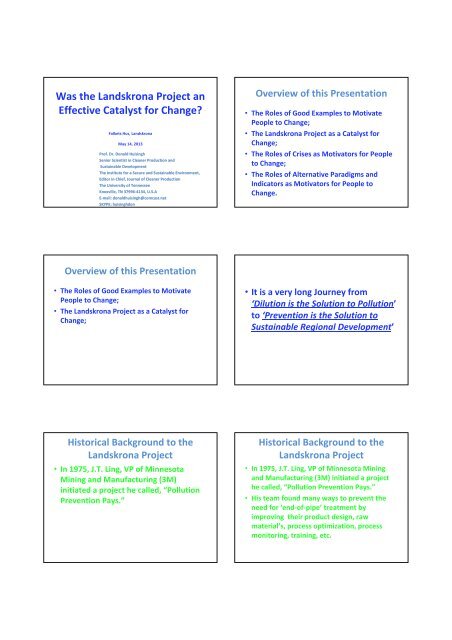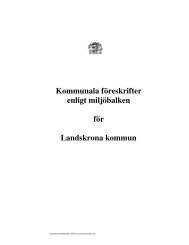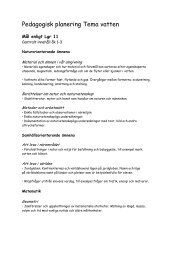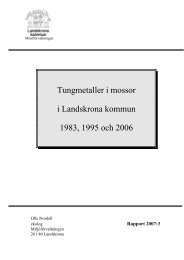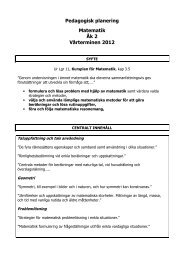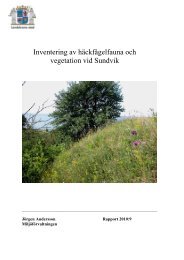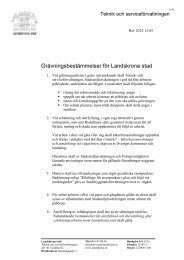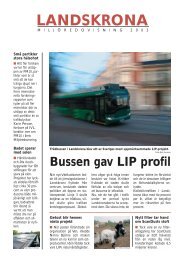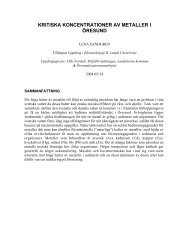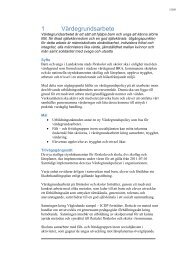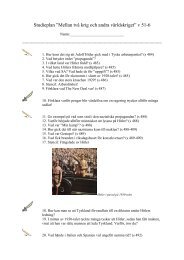Was the Landskrona Project an Effective Catalyst for Change?
Was the Landskrona Project an Effective Catalyst for Change?
Was the Landskrona Project an Effective Catalyst for Change?
You also want an ePaper? Increase the reach of your titles
YUMPU automatically turns print PDFs into web optimized ePapers that Google loves.
<strong>Was</strong> <strong>the</strong> <strong>L<strong>an</strong>dskrona</strong> <strong>Project</strong> <strong>an</strong><strong>Effective</strong> <strong>Catalyst</strong> <strong>for</strong> Ch<strong>an</strong>ge?Folkets Hus, <strong>L<strong>an</strong>dskrona</strong>May 14, 2013Prof. Dr. Donald HuisinghSenior Scientist in Cle<strong>an</strong>er Production <strong>an</strong>dSustainable DevelopmentThe Institute <strong>for</strong> a Secure <strong>an</strong>d Sustainable Environment,Editor in Chief, Journal of Cle<strong>an</strong>er ProductionThe University of TennesseeKnoxville, TN 37996‐4134, U.S.AE‐mail: donaldhuisingh@comcast.netSKYPE: huisinghdonOverview of this Presentation• The Roles of Good Examples to MotivatePeople to Ch<strong>an</strong>ge;• The <strong>L<strong>an</strong>dskrona</strong> <strong>Project</strong> as a <strong>Catalyst</strong> <strong>for</strong>Ch<strong>an</strong>ge;• The Roles of Crises as Motivators <strong>for</strong> Peopleto Ch<strong>an</strong>ge;• The Roles of Alternative Paradigms <strong>an</strong>dIndicators as Motivators <strong>for</strong> People toCh<strong>an</strong>ge.Overview of this Presentation• The Roles of Good Examples to MotivatePeople to Ch<strong>an</strong>ge;• The <strong>L<strong>an</strong>dskrona</strong> <strong>Project</strong> as a <strong>Catalyst</strong> <strong>for</strong>Ch<strong>an</strong>ge;• It is a very long Journey from‘Dilution is <strong>the</strong> Solution to Pollution’to ‘Prevention is <strong>the</strong> Solution toSustainable Regional Development’Historical Background to <strong>the</strong><strong>L<strong>an</strong>dskrona</strong> <strong>Project</strong>• In 1975, J.T. Ling, VP of MinnesotaMining <strong>an</strong>d M<strong>an</strong>ufacturing (3M)initiated a project he called, “PollutionPrevention Pays.”Historical Background to <strong>the</strong><strong>L<strong>an</strong>dskrona</strong> <strong>Project</strong>• In 1975, J.T. Ling, VP of Minnesota Mining<strong>an</strong>d M<strong>an</strong>ufacturing (3M) initiated a projec<strong>the</strong> called, “Pollution Prevention Pays.”• His team found m<strong>an</strong>y ways to prevent <strong>the</strong>need <strong>for</strong> ‘end‐of‐pipe’ treatment byimproving <strong>the</strong>ir product design, rawmaterial’s, process optimization, processmonitoring, training, etc.
Historical Background to <strong>the</strong><strong>L<strong>an</strong>dskrona</strong> <strong>Project</strong>• In 1975, J.T. Ling, VP of Minnesota Mining<strong>an</strong>d M<strong>an</strong>ufacturing (3M) initiated a projec<strong>the</strong> called, “Pollution Prevention Pays.”• His team found m<strong>an</strong>y ways to prevent <strong>the</strong>need <strong>for</strong> ‘end‐of‐pipe’ treatment byimproving <strong>the</strong>ir product design, rawmaterial’s, process optimization, processmonitoring, training, etc.• Since 1975, 3M has saved Billions of $’s.Leadership from <strong>the</strong> Governorof North Carolina• I worked as <strong>the</strong> science policy advisor toGovernor Hunt from 1980 ‐1983;• I in<strong>for</strong>med Gov. Hunt, about 3M’sfindings <strong>an</strong>d proposed we host aconference with J.T. Ling as keynotespeaker;• We pl<strong>an</strong>ned <strong>an</strong>d hosted a conference;Conference“Pollution Prevention Pays:Ecology with Economy as Policy”May 1982Winston Salem North CarolinaResults?• Four hundred particip<strong>an</strong>ts from government,industry, university faculty <strong>an</strong>d students <strong>an</strong>dNGOs;Results?• Four hundred particip<strong>an</strong>ts from government,industry, university faculty <strong>an</strong>d students <strong>an</strong>dNGOs;• Published Book through Pergamon‐1982 ;Results?• Four hundred particip<strong>an</strong>ts from government,industry, university faculty <strong>an</strong>d students <strong>an</strong>dNGOs;• Published Book through Pergamon 1982;• Legislation passed in North Carolinalegislature to promote Pollution Prevention1983;
Results?• Four hundred particip<strong>an</strong>ts from government,industry, university faculty <strong>an</strong>d students <strong>an</strong>dNGOs;• Published Book through Pergamon‐1982;• Legislation passed in North Carolinalegislature to promote Pollution Prevention‐1983;• Established <strong>the</strong> first Pollution PreventionIndustrial Technical Assist<strong>an</strong>ce Center‐1983<strong>L<strong>an</strong>dskrona</strong> <strong>Project</strong> –August 1987• Th<strong>an</strong>ks to Michael Backm<strong>an</strong>, LarsSiljebratt, funders, comp<strong>an</strong>y leaders <strong>an</strong>d<strong>the</strong>ir employees <strong>an</strong>d o<strong>the</strong>rs, <strong>the</strong> first‘Pollution Prevention’ project in Europewas started.Through Learning by Doing!• The lessons learned by <strong>the</strong> team in workingwith <strong>the</strong> <strong>L<strong>an</strong>dskrona</strong> comp<strong>an</strong>ies, helped<strong>the</strong>m to become effective “ch<strong>an</strong>ge agents”;Through Learning by Doing!• The lessons learned by <strong>the</strong> team in workingwith <strong>the</strong> <strong>L<strong>an</strong>dskrona</strong> comp<strong>an</strong>ies, helped<strong>the</strong>m to become effective “ch<strong>an</strong>ge agents”;• The lessons learned by <strong>the</strong> comp<strong>an</strong>y peoplehelped <strong>the</strong>m to make improvements in <strong>the</strong>short <strong>an</strong>d longer term;Through Learning by Doing!• The lessons learned by <strong>the</strong> team in workingwith <strong>the</strong> <strong>L<strong>an</strong>dskrona</strong> comp<strong>an</strong>ies, helped<strong>the</strong>m to become effective “ch<strong>an</strong>ge agents”;• The lessons learned by <strong>the</strong> comp<strong>an</strong>y peoplehelped <strong>the</strong>m to make improvements in <strong>the</strong>short <strong>an</strong>d longer term;• The lessons learned by <strong>the</strong> comp<strong>an</strong>y peoplehelped <strong>the</strong>m to encourage o<strong>the</strong>rs to begin toask what c<strong>an</strong> we do in our comp<strong>an</strong>ies from apreventative perspective?Through Diffusion• The findings of <strong>the</strong> <strong>L<strong>an</strong>dskrona</strong> projectcatalyzed o<strong>the</strong>r projects in:• Norway, Ne<strong>the</strong>rl<strong>an</strong>ds, U.K., Denmark,Finl<strong>an</strong>d, Austria, Irel<strong>an</strong>d, Pol<strong>an</strong>d, CzechRepublic,
Through Diffusion• The findings of <strong>the</strong> <strong>L<strong>an</strong>dskrona</strong> projectcatalyzed o<strong>the</strong>r projects in:• Norway, Ne<strong>the</strong>rl<strong>an</strong>ds, U.K., Denmark,Finl<strong>an</strong>d, Austria, Irel<strong>an</strong>d, Pol<strong>an</strong>d, CzechRepublic,• Hungary, Italy, Belgium, Portugal,Switzerl<strong>an</strong>d, New Zeal<strong>an</strong>d, Australia,China, India, Korea, C<strong>an</strong>ada, Mexico &Egypt <strong>an</strong>d in about 45 o<strong>the</strong>r countriesThrough Leadership & Diffusion– UNEP’s & UNIDO’s Program <strong>for</strong> <strong>the</strong>development of National SustainableConsumption <strong>an</strong>d Production ProductionCenters in 50 developing countries;Through Leadership & Diffusion– UNEP’s & UNIDO’s Program <strong>for</strong> <strong>the</strong>development of National SustainableConsumption <strong>an</strong>d Production ProductionCenters in 50 developing countries;– Establishment of Sustainable Consumption& Production Roundtables in:Through Educational & Researchef<strong>for</strong>ts in Universities• The International Institute <strong>for</strong> IndustrialEnvironmental Economics (IIIEE) in LundUniversity was established, due, in large part,to <strong>the</strong> catalytic roles of <strong>the</strong> <strong>L<strong>an</strong>dskrona</strong>project;The U.S. Europe C<strong>an</strong>adaThe Asia Australia MexicoPacific‐RegionBrazil AfricaThrough Educational & Researchef<strong>for</strong>ts in Universities• The International Institute <strong>for</strong> IndustrialEnvironmental Economics (IIIEE) in LundUniversity was established, due, in large part,to <strong>the</strong> catalytic roles of <strong>the</strong> <strong>L<strong>an</strong>dskrona</strong>project;• Similar educational M.Sc., <strong>an</strong>d Ph.D programsnow exist in about 200 universities, globally,due to <strong>the</strong> ‘preventative approaches of <strong>the</strong><strong>L<strong>an</strong>dskrona</strong> project <strong>an</strong>d to similar projects.Through Regulations to PromotePreventative Approaches• The U.S., C<strong>an</strong>ada, China, The EU <strong>an</strong>dm<strong>an</strong>y o<strong>the</strong>r regions have developedregulations that foster implementationof Cle<strong>an</strong>er Production & Toxics Usereduction approaches.
Through International Org<strong>an</strong>izationalEf<strong>for</strong>ts to Promote PreventativeApproachesAgenda 21;The Earth Charter;Millennium DevelopmentGoalsThe Precautionary Principle;The Natural Step Principles;The Melbourne Principles;The Decade of Education <strong>for</strong>Sustainable Development(EfSD) 2005 – 2014;The Equator Principles <strong>for</strong>Sustainable Fin<strong>an</strong>ce.Through NGO ef<strong>for</strong>ts to PromotePreventative ApproachesThe C<strong>an</strong>adi<strong>an</strong>‐Americ<strong>an</strong> Cle<strong>an</strong> ProductionAction Org<strong>an</strong>izationGreen Peace’s Actions on ToxicsThe World Wildlife FederationThe Friends of <strong>the</strong> EarthThe Nature Conserv<strong>an</strong>cyAnd m<strong>an</strong>y o<strong>the</strong>rs, which are working onprevention of environmental <strong>an</strong>d hum<strong>an</strong>health problemsThrough ISO <strong>an</strong>dGRI‐related ef<strong>for</strong>ts• The ISO series of ISO 9000, 14000,18000, 26000 <strong>an</strong>d o<strong>the</strong>rs help comp<strong>an</strong>yleaders to reduce risks, waste <strong>an</strong>denvironmental damages;• The Global Reporting Initiative <strong>an</strong>dAdv<strong>an</strong>ces in Corporate SocialResponsibility Reporting;Through CurrentISO/TC 268 Ef<strong>for</strong>ts• Sustainable Development of RegionalSustainable M<strong>an</strong>agement;• Development of Smart/Sustainable CityIndicators <strong>an</strong>d IndicesThrough InternationalScientific Journals• The International Journal of IndustrialEcology;Through InternationalScientific Journals• The International Journal of IndustrialEcology;• The International Journal of Life CycleAssessment;•
Through InternationalScientific Journals• The International Journal of IndustrialEcology;• The International Journal of Life CycleAssessment;• The International Journal of Sustainability inHigher Education;Through InternationalScientific Journals• The International Journal of IndustrialEcology;• The International Journal of Life CycleAssessment;• The International Journal of Sustainability inHigher Education;• The Journal of Cle<strong>an</strong>er Production wasfounded in 1992, is now published in twentyfourvolumes per year;•Some Special Issues of <strong>the</strong>Journal of Cle<strong>an</strong>er Production• Sustainable Fisheries;• Sustainable Agriculture;• Sustainable Tourism;Some Special Issues of <strong>the</strong>Journal of Cle<strong>an</strong>er Production• Sustainable Fisheries;• Sustainable Agriculture;• Sustainable Tourism;• Toward Zero <strong>Was</strong>te;• Green Supply ChainM<strong>an</strong>agement;• International Trade in Bio-Fuels;Some Special Issues of <strong>the</strong>Journal of Cle<strong>an</strong>er Production• Sustainable Fisheries;• Sustainable Agriculture;• Sustainable Tourism;• Toward Zero <strong>Was</strong>te;• Green Supply ChainM<strong>an</strong>agement;• International Trade in Bio-Fuels;• Hydrogen production by microorg<strong>an</strong>isms.
Some Special Issues of <strong>the</strong>Journal of Cle<strong>an</strong>er Production• Industrial Ecology/ IndustrialSymbiosis;Some Special Issues of <strong>the</strong>Journal of Cle<strong>an</strong>er Production• Industrial Ecology/ IndustrialSymbiosis;• Sustainable Production <strong>an</strong>dConsumption;• Extended Producer Responsibility(EPR);Some Special Issues of <strong>the</strong>Journal of Cle<strong>an</strong>er Production• Industrial Ecology/ IndustrialSymbiosis;• Sustainable Production <strong>an</strong>dConsumption;• Extended Producer Responsibility(EPR);• Innovation <strong>an</strong>d InnovationDiffusion;• Sustainable Tr<strong>an</strong>sportation;Some Special Issues of <strong>the</strong>Journal of Cle<strong>an</strong>er Production• Zero Emissions Technologies;– Electroplating, Lea<strong>the</strong>r making, PapermakingSome Special Issues of <strong>the</strong>Journal of Cle<strong>an</strong>er Production• Zero Emissions Technologies;– Electroplating, Lea<strong>the</strong>r making, Papermaking• Innovations in:– Green Chemistry;– Green Engineering;– Green Buildings;– Global Supply Chain M<strong>an</strong>agement;Some Special Issues of <strong>the</strong>Journal of Cle<strong>an</strong>er Production• Sustainable Urb<strong>an</strong>Tr<strong>an</strong>s<strong>for</strong>mation;
Some Special Issues of <strong>the</strong>Journal of Cle<strong>an</strong>er Production• Sustainable Urb<strong>an</strong>Tr<strong>an</strong>s<strong>for</strong>mation;• Co-benefits in Urb<strong>an</strong> <strong>an</strong>dRegional Tr<strong>an</strong>s<strong>for</strong>mation;Some Special Issues of <strong>the</strong>Journal of Cle<strong>an</strong>er Production• Sustainable Urb<strong>an</strong>Tr<strong>an</strong>s<strong>for</strong>mation;• Co-benefits in Urb<strong>an</strong> <strong>an</strong>dRegional Tr<strong>an</strong>s<strong>for</strong>mation;• Women, Water, <strong>Was</strong>te, Wisdom<strong>an</strong>d Wealth;Some Special Issues of <strong>the</strong>Journal of Cle<strong>an</strong>er Production• Sustainable Urb<strong>an</strong>Tr<strong>an</strong>s<strong>for</strong>mation;• Co-benefits in Urb<strong>an</strong> <strong>an</strong>dRegional Tr<strong>an</strong>s<strong>for</strong>mation;• Women, Water, <strong>Was</strong>te, Wisdom<strong>an</strong>d Wealth;• Education <strong>for</strong> SustainableSocieties (Six Special Issueshave been published.)Some Special Issues of <strong>the</strong>Journal of Cle<strong>an</strong>er Production• Growth, Recession or Degrowth <strong>for</strong>Sustainability <strong>an</strong>d Equity?• Regional Sustainable Development <strong>an</strong>d<strong>the</strong> Circular Economy;• Sustainable Mining <strong>an</strong>d The Cradle‐to‐Cradle Economy;• Le<strong>an</strong> <strong>an</strong>d Green Production.In this context are all comp<strong>an</strong>iesin all countries using <strong>the</strong>sepreventative approaches?In this context are all comp<strong>an</strong>iesin all countries using <strong>the</strong>sepreventative approaches?• No!!!!• Why not?
Overview of this Presentation• It is a very long Journey from‘Dilution is <strong>the</strong> Solution to Pollution’to ‘Prevention is <strong>the</strong> Solution toSustainable Regional Development’The Roles of Crises asMotivators <strong>for</strong> People to Ch<strong>an</strong>geWhat are <strong>the</strong> Roles of Crises asMotivators <strong>for</strong> Ch<strong>an</strong>ge?• Carson’s “Silent Spring” ‐ pesticides• Colburn’s “Our Stolen Future”‐ endocrinedisruptersWhat are <strong>the</strong> Roles of Crises asMotivators <strong>for</strong> Ch<strong>an</strong>ge?• Carson’s “Silent Spring” ‐ pesticides• Colburn’s “Our Stolen Future”‐ endocrinedisrupters• Ozone layer thinning‐ halogenatedsubst<strong>an</strong>cesWhat are <strong>the</strong> Roles of Crises asMotivators <strong>for</strong> Ch<strong>an</strong>ge?• Carson’s “Silent Spring” ‐ pesticides• Colburn’s “Our Stolen Future”‐ endocrinedisrupters• Ozone layer thinning‐ halogenatedsubst<strong>an</strong>ces• Nuclear reactor meltdowns‐radio‐activesubst<strong>an</strong>ce releases to <strong>the</strong> environment• Climate ch<strong>an</strong>ge‐ carbon dioxide <strong>an</strong>d meth<strong>an</strong>e• http://www.worldwatch.org/brain/features/timeline/timeline.htm危 机Crisis
危D<strong>an</strong>ger机Opportunity危 机CrisisAir Pollution Episodes• M<strong>an</strong>y of <strong>the</strong> challenges highlightedearlier were chronic, long‐termproblems;• Sometimes we also have short‐termepisodes such as severe smog;1930.12 Belgium Meuse Valley fogCausesFive of <strong>the</strong> top ten environmentalpollution incidents in 20 th centuryConsequencescombination of industrial air pollution <strong>an</strong>d climaticconditions, pollut<strong>an</strong>ts: SO 2 , SO 363 deaths in one week; main symptom was dyspnea(shortness of breath); cattle were also affected1943 Los Angeles, USA Photochemical smogCausesConsequencesEmission of CH, NOx, CO from vehicles, emissions fromrefinery pl<strong>an</strong>tsTrees died in high mountains; $1.5 billion loss due to airpollution in 1950; 75% of <strong>the</strong> citizens were seriously affectedby respiratory <strong>an</strong>d eye infections in 1970.
1948.10.16‐21 Pennsylv<strong>an</strong>ia, USA Donora smogCausesThe town lies in <strong>the</strong> valley with mountains on both sides;toxic gases such as SO2, NOx, HF were emitted fromsulphuric acid <strong>an</strong>d steel pl<strong>an</strong>t & accumulated in <strong>the</strong>valleyConsequences 20 deaths <strong>an</strong>d 7,000 sicknesses in Donora (with 14,000people in total); symptoms were eye diseases,respiratory <strong>an</strong>d digestive diseases were domin<strong>an</strong>t1952.12.5‐9 London, UK Great smogCausesConsequencesCO2, CO, SO2, TSP emission from coal burning; vehicleexhaust—particularly from diesel‐fuelled buses; heavilypolluted air from Continental Europe4000 deaths in four days; symptoms: bronchitis,coronary heart , tuberculosis; 52 of 300 cattle werepoisoned in <strong>the</strong> cattle exhibition1961 Yokkaichi, Jap<strong>an</strong> Yokkaichi asthmaCausesConsequencesSO2, TSP emissions from petrochemical processingfacilities <strong>an</strong>d refineriessevere cases of chronic obstructive pulmonary disease,chronic bronchitis, pulmonary emphysema, <strong>an</strong>d bronchialasthma rose quickly1961 Yokkaichi, Jap<strong>an</strong> Yokkaichi asthmaCausesConsequencesSO2, TSP emissions from petrochemical processingfacilities <strong>an</strong>d refineriessevere cases of chronic obstructive pulmonary disease,chronic bronchitis, pulmonary emphysema, <strong>an</strong>d bronchialasthma rose quicklyWea<strong>the</strong>r Conditions of ChinaonJ<strong>an</strong> 30, 2013Ti<strong>an</strong> ‘<strong>an</strong> Men SquareThe Oriental Pearl TVTower
Zibo CityBeijing’s Sky 2012.3.1‐2013.3.5 8:00‐9:00Sh<strong>an</strong>dong UniversityThe Air Quality Index of four Cities inChinaSOURCES OF CARBON DIOXIDE75Data Source: EPASoot in exhaust spews out black carbonControlled burns release huge amountsof sooty black carbon into <strong>the</strong> atmosphere.
Black carbon, a short‐lived pollut<strong>an</strong>t(shown in purple), shrouds <strong>the</strong> globe.Fossil Fuel & Cement CO 2 Emissions: Top EmittersCarbon Emissions per year(C tons x 1,000,000)25002000150010005000IndiaRussi<strong>an</strong> Fed.Time (y)Global Carbon <strong>Project</strong> 2011; Peters et al. 2011 (in review); Data: Boden, Marl<strong>an</strong>d, Andres-CDIAC 2011ChinaUSAJap<strong>an</strong>1990 93 95 97 99 2001 03 05 07 20102010 GrowthRates9.9%4.0%9.0%5.6%6.5%Concentration of Carbon Dioxide in Antarctic iceMeth<strong>an</strong>e concentration in <strong>the</strong> Antarctic ice310800290270250230210190170concentration (PPMs)750700650600550500450400350Concentration of meth<strong>an</strong>e in Ppbs450,000400,000350,000300,000250,000200,000150,000100,00050,0000150450,000400,000350,000300,000250,000200,000150,000100,00050,0000300Time in years be<strong>for</strong>e <strong>the</strong> presentTime in years be<strong>for</strong>e <strong>the</strong> present450,000Atmospheric Temperature Variations as detectedfrom <strong>the</strong> Antarctic ice400,000350,000300,000250,000200,000150,000100,000Time in years be<strong>for</strong>e <strong>the</strong> present50,000420-2-4-6-8-10-120Differences in Tempreture (°C)R<strong>an</strong>ges <strong>an</strong>d concentrationsduring 450,000 years• Carbon dioxide concentration r<strong>an</strong>ge =(185 – 295 PPM) (2012 393 PPM)<strong>Project</strong>ed by 2050 tobe between 450 & 750 PPM!• Meth<strong>an</strong>e concentration r<strong>an</strong>ge =(340 -760 PPB) (2004 1700 PPB)<strong>Project</strong>ed by 2050???• The average temperature r<strong>an</strong>geduring this period was 10° C.
Concentration of Carbon Dioxide as measured inColorado, C<strong>an</strong>ada <strong>an</strong>d at The South PoleConcentration en PPMs390380370360350340330320SouthPoleColoradoC<strong>an</strong>adaEne-75Ene-76Dic-76Dic-77Ene-79Ene-80Dic-80Dic-81Ene-83Ene-84Dic-84Dic-85Ene-87Ene-88Dic-88Dic-89Ene-91Ene-92Dic-92Dic-93Ene-95Ene-96Dic-96Dic-97Ene-99Ene-00Dic-00Dic-01Ene-03Ene-04Increase in Carbon DioxideConcentrationat Mauna Loa, Hawaii‐‐‐‐‐‐‐‐‐‐‐‐‐‐‐‐‐‐‐‐‐‐‐‐‐‐‐‐‐‐‐‐‐‐‐‐‐‐‐‐‐‐‐‐‐‐‐‐‐‐‐1880 285 ppm (Est.)1958 315 ppm2012 393 ppmIncrease of 108 ppm in 132 years= .82 ppm/yr.Annual Growth Rates(decadal me<strong>an</strong>s)2012: 393 ppmAtmospheric CO 2 ConcentrationAnnual Mea Growth Rate (ppm y -1 )2010 2.372009 1.632008 1.812007 2.111970 – 1979: 1.3 ppm y -12006 1.831980 – 1989: 1.6 ppm y 12005 2.392004 1.581990 – 1999: 1.5 ppm y -12003 2.202002 2.402000 - 2010: 1.9 ppm y -12001 1.892000 1.22News, May 12, 2013• Mauna Loa,Hawaii• 400 PPM CarbonDioxide!• Highest in sinceat least threemillion yearsago!Data Source: Thomas Conway, 2011, NOAA/ESRL + Scripts InstitutionWhat is <strong>the</strong> net qu<strong>an</strong>tity of carbondioxide that is being added each day to<strong>the</strong> atmosphere, globally?What is <strong>the</strong> net qu<strong>an</strong>tity of carbondioxide that is being added each day to<strong>the</strong> atmosphere, globally?Estimates vary from 100,000,000 tonsper day to more th<strong>an</strong> 1,000,000,000tons per day!
The Shellfish Know Climate Ch<strong>an</strong>ge is RealIncreasing Average TemperaturesThe rate of increase on l<strong>an</strong>d is accelerating.Warming <strong>for</strong> <strong>the</strong> entire 20th century clocks inat•The pH of Seawater is approximately 8.2•Calcifiers such as Shellfish <strong>an</strong>d Corals use calcium carbonate to makeshells/skeletons•At pHs below 8.1 <strong>the</strong>y have difficulty making <strong>the</strong>se structures;•Coral dieoff is occurring <strong>an</strong>d oysters, clams are decreasing, causingeconomic <strong>an</strong>d environmental impacts;•These filter feeders per<strong>for</strong>m numerous oce<strong>an</strong> cle<strong>an</strong>ing functions;•If we continue to increase <strong>the</strong> global carbon dioxide concentrations,by 2100, <strong>the</strong> oce<strong>an</strong>’s pH could be 7.8 worldwide!Chasing Ice ‐ A documentary aboutreceding glaciersThe Earth is Shrinking!!!• The Hum<strong>an</strong> Population continues toincrease:– 70,000,000 per year!– That is approximately 7X <strong>the</strong>total population of Sweden arebeing added to <strong>the</strong> earth eachyear!– From, “The Earth is Shrinking:Adv<strong>an</strong>cing deserts <strong>an</strong>d Rising SeasSqueezing Civilization,”by Lester Brownhttp://www.earthpolicy.org/updates/2006/update61.htmThe Earth is Shrinking!!!• Desserts are spreading;– China is losing productive l<strong>an</strong>dto deserts at <strong>an</strong> acceleratingrate• 1950 – 1975 <strong>the</strong>y lost 1,560sq. km/yr..• By 2000 <strong>the</strong>y lost 2,480 sq.km/yr.– In recent years Afgh<strong>an</strong>ist<strong>an</strong> lost100 villages <strong>an</strong>d Ir<strong>an</strong> lost 124villages due to adv<strong>an</strong>cingdesserts;What is Ahead on ourRoad to <strong>the</strong> Future?
Overview of this PresentationThe Roles of AlternativeParadigms <strong>an</strong>d Indicators asMotivators <strong>for</strong> People to Ch<strong>an</strong>ge.The Chinese Government issupporting its citizen’sinvolvement with <strong>the</strong> <strong>the</strong>me:“Tr<strong>an</strong>s<strong>for</strong>mation to <strong>an</strong>Ecologically Sound Society as<strong>the</strong> Model <strong>for</strong> FutureDevelopmentNEW CHALLENGES• Make <strong>the</strong> Tr<strong>an</strong>sition to Post FossilCarbon Societies;• Low Toxicity Raw Materials &Products;• Green Chemistry, GreenEngineering, Green Buildings;• Responsible Supply ChainM<strong>an</strong>agement;• Bio-mimicry: Learning fromNature/Maintaining Bio-Diversity.Jeremy Rifkin’s,“The Third Industrial Revolution”• Society built upon energy efficiency <strong>an</strong>drenewable energy;Jeremy Rifkin’s,“The Third Industrial Revolution”• Society built upon renewable energy;• Buildings serve as mini‐power pl<strong>an</strong>ts,which feed into <strong>the</strong> smart, decentralizedenergy grid;
Jeremy Rifkin’s,“The Third Industrial Revolution”• Society built upon renewable energy;• Buildings designed to serve as minipowerpl<strong>an</strong>ts that feed electrical energyinto <strong>the</strong> smart, decentralized energygrid;• Some of <strong>the</strong> energy is stored ashydrogen;Jeremy Rifkin’s,“The Third Industrial Revolution”• Society built upon renewable energy;• Buildings designed to serve as minipowerpl<strong>an</strong>ts that feed electrical energyinto <strong>the</strong> decentralized energy grid;• Some of <strong>the</strong> energy is stored ashydrogen or in Electric Vehicle batteries;• Smart energy internet grid distributionsystem.Sustainable Development InHigher Education Requires Usto Adopt– New thinking;Sustainable Development InHigher Education Requires Usto Adopt– New thinking;– New paradigms;Sustainable Development InHigher Education Requires Usto Adopt– New thinking;– New paradigms;– New policies;Sustainable Development InHigher Education Requires Usto Adopt– New thinking;– New paradigms;– New policies;– New technologies;
Sustainable Development InHigher Education Requires Usto Adopt– New thinking;– New paradigms;– New policies;– New technologies;– New m<strong>an</strong>agement;Sustainable Development InHigher Education Requires Usto Adopt– New thinking;– New paradigms;– New policies;– New technologies;– New m<strong>an</strong>agement;– New cooperation;Sustainable Development InHigher Education Requires Usto Adopt– New thinking;– New paradigms;– New policies;– New technologies;– New m<strong>an</strong>agement;– New cooperation;– New values.Be a catalyst <strong>an</strong>d role model<strong>for</strong> ch<strong>an</strong>ge• Learn how <strong>the</strong> system really works;• Underst<strong>an</strong>d how to work with <strong>the</strong>system by effectively using leveragepoints;• Be a role model <strong>for</strong> <strong>the</strong> ch<strong>an</strong>ges youhope to see evolve in society.Be a catalyst <strong>an</strong>d role model<strong>for</strong> ch<strong>an</strong>ge• Foster development of innovativeindustrial processes that mimicnatural environmental processes viaGreen chemistry, engineering,architecture <strong>an</strong>d products;• Foster innovative development thatis based upon <strong>the</strong> fact that socialissues are fin<strong>an</strong>cial issuesBe a catalyst <strong>an</strong>d role model<strong>for</strong> ch<strong>an</strong>ge• Move increasingly from ”site thinking”to ”regional thinking”;• Move from production thinking tosustainable production & consumptionthinking;• Foster integration of ethical <strong>an</strong>d socialfactors into sustainable city <strong>an</strong>dregional pl<strong>an</strong>ning;
Be a catalyst <strong>an</strong>d role model<strong>for</strong> ch<strong>an</strong>ge• Foster <strong>the</strong> development ofSustainable eco-communities basedupon bio-regionalism;• Participate in international networkson sustainable city & regionaldevelopment.Be a catalyst <strong>an</strong>d role model<strong>for</strong> ch<strong>an</strong>ge• Develop <strong>an</strong>d en<strong>for</strong>ce regulationsdesigned to achieve sustainablesocieties;• Develop ecological, economic<strong>an</strong>d ethical sustainabilityper<strong>for</strong>m<strong>an</strong>ce indicators;Be a catalyst <strong>an</strong>d role model<strong>for</strong> ch<strong>an</strong>ge• Use <strong>the</strong> sustainabilityper<strong>for</strong>m<strong>an</strong>ce indicators tomonitor progress towardsustainable societies;• Report on <strong>the</strong> progress or lackof progress <strong>an</strong>d correctpolicies, procedures <strong>an</strong>dprocesses as needed危 机Crisis危D<strong>an</strong>ger
机OpportunityAlternatives to Gross National Product (GNP)or Gross Domestic Product (GDP)– The Happiness Index(HI);– The Quality of Life Index(QoLI);– The Wellness Index (WI);– The Inclusive WealthIndex (IWI);– World Happiness Index(WHI);– The Happy Pl<strong>an</strong>et Index;– The Gallup World Poll(QWP);– The World Values Survey(WVS)– The Europe<strong>an</strong> SocialSurvey (ESS)•– The OECD Better LifeIndex– The UNDP’s Hum<strong>an</strong>Development Index (HDI);– The True SustainabilityIndex;– Country FuturesIndicators;– Hum<strong>an</strong> DevelopmentIndex (HDI);– The Calvert-HendersonQuality of Life Indictors;– The C<strong>an</strong>adi<strong>an</strong> Index ofWell-Being.SustainableDevelopment Is aJourney........ Not aDestination!!Who should be empowered to makedecisions on international <strong>an</strong>d globalwelfare issues ?• Are we ready & willing to take<strong>the</strong> necessary steps?
Old Polish ProverbIf you don’t w<strong>an</strong>t to dosomething, you c<strong>an</strong> always find<strong>an</strong> excuse!If you do w<strong>an</strong>t to do something,you c<strong>an</strong> always find a way!


